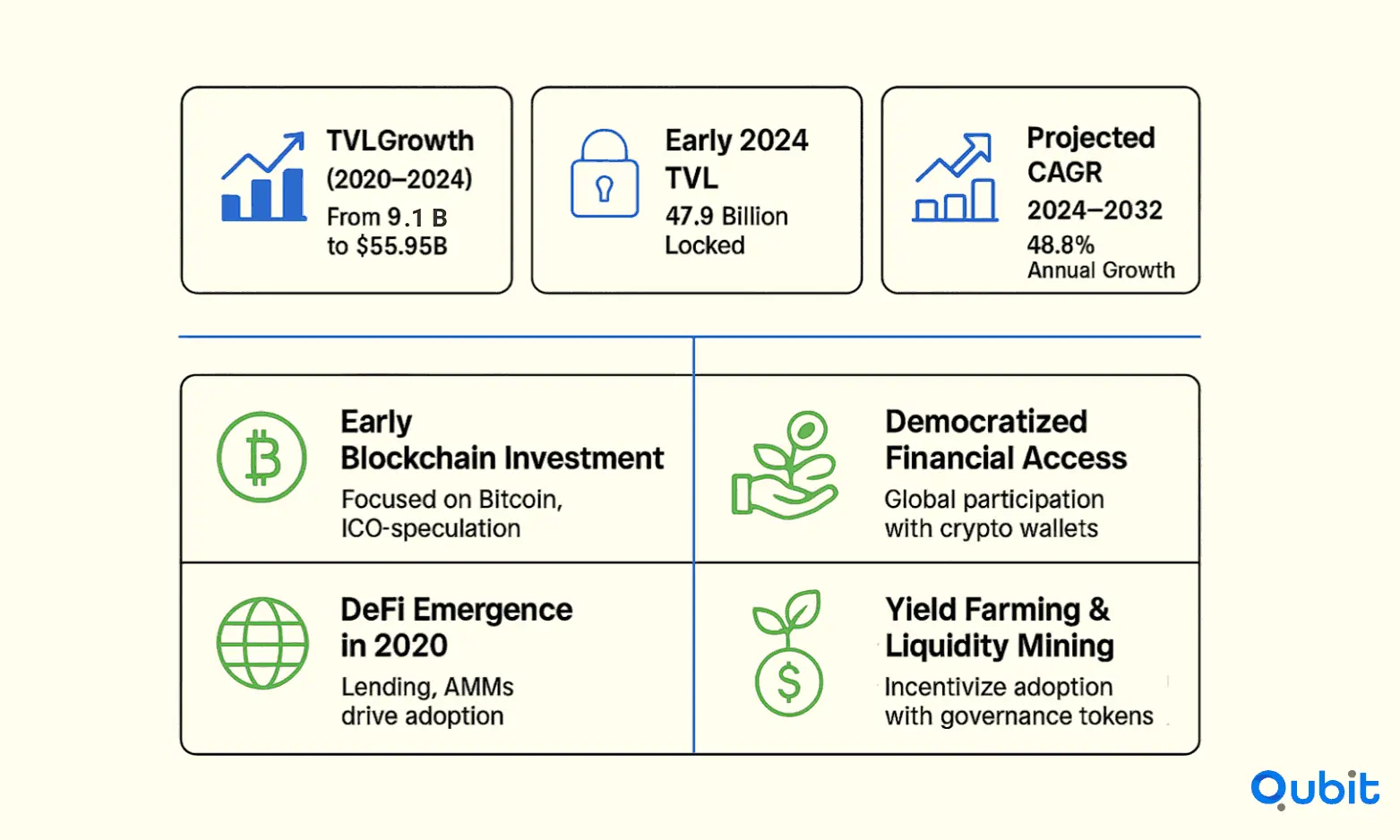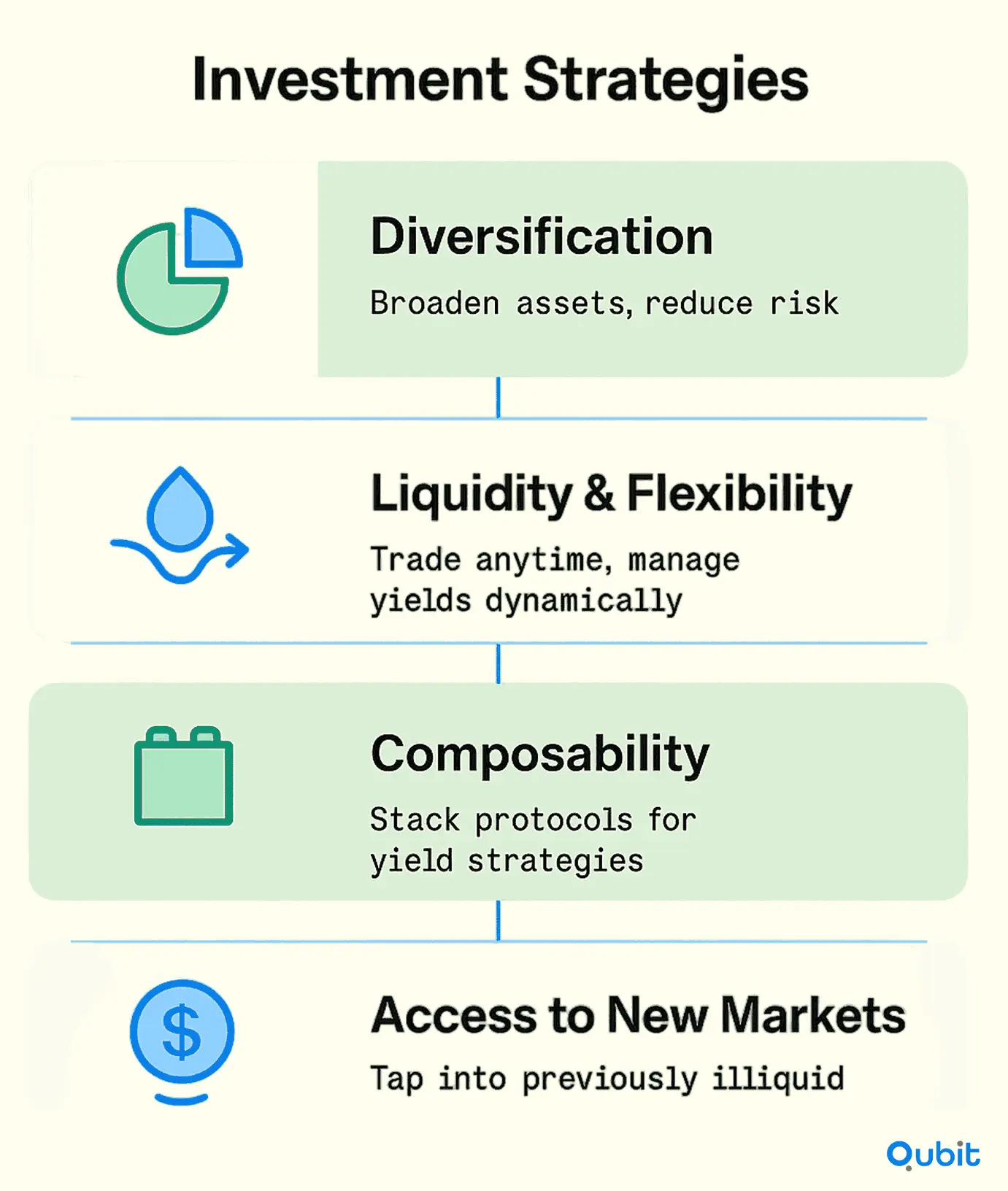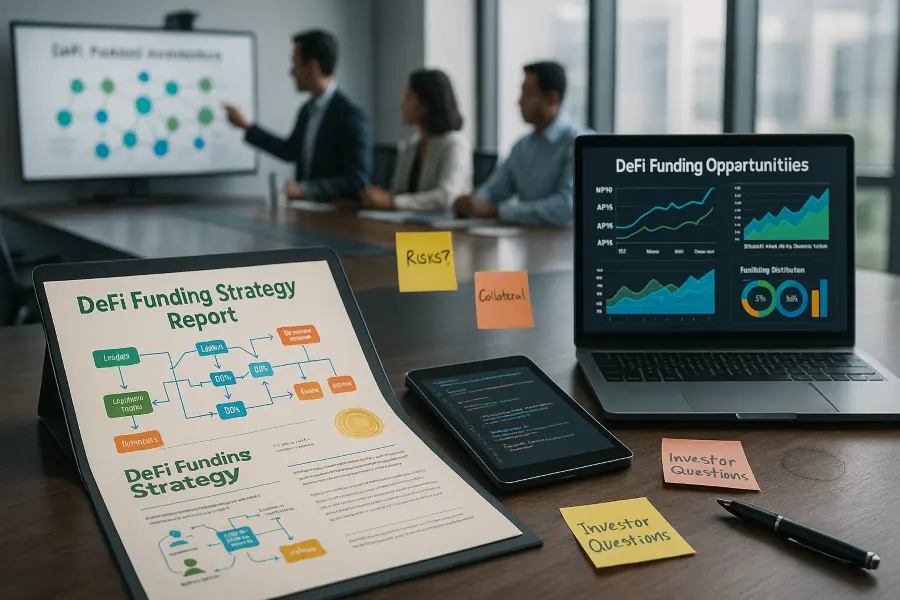Decentralized Finance (DeFi) is reshaping the way investors approach blockchain investments, offering innovative solutions that challenge traditional financial systems. Built on blockchain technology, DeFi eliminates intermediaries, enabling direct peer-to-peer transactions and fostering transparency. This paradigm shift is unlocking new opportunities for individuals and businesses alike, making blockchain investments more accessible and dynamic.
For those unfamiliar with the fundamentals, decentralized finance provides an explanation of DeFi and blockchain technology, detailing how these systems operate and their transformative potential. This article shows how DeFi reshapes investments and benefits founders directly.
What Is DeFi?
DeFi uses smart contracts on blockchains to automate financial services. Users execute loans, trades, and yields without banks or brokers. Platforms like Uniswap, Aave, and MakerDAO exemplify this shift.
Smart contracts self-execute when conditions are met. They eliminate manual settlement delays and cut costs dramatically. For founders, this means faster access to capital and transparent terms.
The Evolution of Blockchain Investments
Early blockchain investments centered on Bitcoin and ICOs. Speculation dominated, with little emphasis on sustainable yields. DeFi emerged in 2020, driven by lending protocols and automated market makers. By July 2020, Total Value Locked in DeFi stood at $9.1 billion. By January 2024, TVL soared to $55.95 billion. This meteoric growth shows investor appetite for decentralized yields.

For a better understanding on how to secure investment you can study different strategies that would help you gain capital for your blockchain startup.
DeFi’s Transformational Impact
DeFi democratizes access to financial tools once reserved for institutions. Anyone with internet and crypto wallet can participate globally. This open model empowers startups to reach wider investor pools.
Yield farming and liquidity mining reward users with governance tokens. These rewards can bootstrap token-based funding without equity dilution. Founders can incentivize early adopters and build engaged communities.
DeFi Adoption Statistics and Market Trends
The DeFi technology market is expected to grow significantly through 2035. Forecasts project rapid adoption across lending, payments, and insurance From 2025 to 2035, DeFi may redefine financial services globally.
Total Value Locked reached around $47.9 billion in early 2024. Market reports show a projected CAGR of 46.8% from 2024 to 2032. These figures underline DeFi’s potential to reshape capital flows.
Key Trends Shaping DeFi in 2025
Decentralized finance (DeFi) continues to redefine the financial ecosystem, introducing groundbreaking innovations that challenge traditional systems. From automated market makers (AMMs) to AI-powered automation, the latest trends are reshaping how users interact with financial tools. As DeFi evolves, its integration with traditional financial instruments and the emergence of robust governance mechanisms are driving unprecedented growth and diversification.
Real-World Asset (RWA) Tokenization
Tokenization is the process of representing real-world assets (like real estate, commodities, or art) as blockchain tokens. In 2025, RWA tokenization is a major trend, enabling:
- Broader Access: Previously exclusive investment opportunities become available to a global audience
- Fractional Ownership: Investors can own a piece of an asset, lowering entry barriers.
- Increased Liquidity: Traditionally illiquid assets become tradable on DeFi platforms.
Automated Market Makers (AMMs): Revolutionizing Exchanges
AMMs have transformed decentralized exchanges by eliminating the need for traditional order books. Instead, liquidity pools enable seamless trading, ensuring users can swap assets without intermediaries. The continuous evolution of AMM development is introducing features like dynamic fee structures and enhanced liquidity provisioning, further improving user experience.
Cross-Chain Interoperability
DeFi’s early days were fragmented, with most activity on Ethereum. Now, cross-chain solutions (e.g., Polkadot, Cosmos) enable assets and data to move seamlessly between blockchains, increasing liquidity and unlocking new investment strategies
AI-Powered Platforms
Artificial Intelligence is being integrated into DeFi for:
- Enhanced Security: AI helps detect fraud and vulnerabilities in smart contracts
- Risk Management: AI analyzes on-chain data to optimize lending, borrowing, and trading decisions.
- Automated Trading: Bots and algorithms execute trades based on market conditions.
Institutional Adoption
Major financial institutions are entering DeFi, bringing capital, credibility, and new products. The approval of spot Bitcoin and Ethereum ETFs in the U.S. has opened the door to mainstream participation, and banks are integrating DeFi protocols into their offerings
Stablecoin Innovations and Enhanced Governance
Stablecoins remain a critical component of DeFi, offering stability in volatile markets. Recent developments in stablecoin frameworks are focusing on transparency and security, ensuring they remain reliable for users and institutions alike. Additionally, enhanced governance tokens are empowering communities to participate in decision-making processes, fostering trust and decentralization.
Your analysis of funding dynamics is further nuanced by the financial mechanisms described in DeFi liquidity funding impact, shedding light on how liquidity pools and stablecoins affect startup valuations.
Central Bank Digital Currencies (CBDCs): Bridging Traditional and Decentralized Finance
CBDCs are gaining traction as governments explore digital currencies to complement their existing monetary systems. While CBDCs are centralized by nature, their integration with DeFi platforms could unlock new possibilities, such as streamlined cross-border payments and improved financial inclusion.
Decentralized Derivatives and Lending Protocols
Decentralized derivatives are providing users with innovative ways to hedge risks and speculate on asset prices. Coupled with efficient lending protocols, these tools are expanding the scope of DeFi, attracting institutional investors and driving mainstream adoption.
Secure Wallet Developments
As DeFi grows, the need for secure wallet solutions becomes paramount. Recent advancements in wallet technology are focusing on user-friendly interfaces, biometric authentication, and multi-signature capabilities, ensuring users can interact with DeFi platforms safely and confidently.
DeFi’s explosive adoption is evident in the numbers. Total Value Locked (TVL) in DeFi soared 137% year-over-year to a staggering $129 billion in January 2025. Mention this figure to highlight the explosive adoption of DeFi.
Benefits of DeFi for Startup Founders
- Access to Capital: Founders can borrow against on-chain collateral instantly.
Tokenized Equity: Issuing tokens can replace traditional share sales.
Global Investor Base: Anyone can invest, widening your funding sources. - Reduced Costs: No banking fees or intermediaries cut overhead.
Transparent Governance: On-chain voting builds investor trust.
Bootstrapped Growth: Yield farming funds operations without equity dilution
How DeFi Is Reshaping Blockchain Investment Strategies

A. Diversification and Portfolio Expansion
DeFi allows investors to diversify across a wide range of assets and protocols, from stablecoins and governance tokens to tokenized real estate and synthetic commodities. This diversification can reduce risk and increase potential returns.
B. Liquidity and Flexibility
Unlike traditional investments, DeFi assets can be traded or staked at any time, providing greater liquidity and flexibility. Investors can move capital between protocols to chase the best yields or manage risk dynamically.
C. Composability and Yield Optimization
DeFi’s “money legos” enable investors to stack protocols for complex strategies. For example, a user might:
- Deposit stablecoins into a lending protocol to earn interest.
- Use the interest-bearing tokens as collateral to borrow another asset.
- Provide that asset as liquidity on a DEX to earn additional fees.
D. Access to New Markets
DeFi opens up markets that were previously inaccessible or illiquid, such as tokenized art, music royalties, or exotic derivatives. This creates new opportunities for both retail and institutional investors.
The Institutionalization of DeFi
In 2025, DeFi is no longer just for crypto enthusiasts. Major banks, asset managers, and fintech firms are integrating DeFi protocols into their platforms. This shift brings:
- Increased Liquidity: Institutional capital boosts market depth and stability.
- Enhanced Legitimacy: Mainstream adoption signals confidence in DeFi’s future.
- New Products: Hybrid models combine DeFi’s efficiency with TradFi’s trust, offering innovative investment options.
DeFi Platforms Leading the Transformation
Some of the most influential DeFi platforms in 2025 include:
- Aave: Decentralized lending and borrowing, with AI-powered credit scoring.
- Uniswap & SushiSwap: Leading decentralized exchanges.
- MakerDAO: Pioneer of decentralized stablecoins and lending.
- Synthetix: Synthetic assets and derivatives.
- Chainlink: Decentralized oracles integrating AI for reliable data feeds.
- Curve Finance: Stablecoin-focused DEX.
- Yearn Finance: Automated yield optimization.
These platforms are continuously evolving, integrating new technologies and expanding their offerings to meet the needs of a growing and diverse investor base.
Risks and Challenges in DeFi Investing
While DeFi offers significant opportunities, it also comes with unique risks:
- Smart Contract Vulnerabilities: Bugs or exploits in smart contracts can lead to loss of funds. Audits and insurance protocols are mitigating these risks, but they remain a concern.
- Regulatory Uncertainty: Despite progress, DeFi operates in a rapidly changing regulatory environment. Compliance and legal risks must be considered, especially for cross-border investments.
- Market Volatility: Crypto assets are highly volatile, and DeFi yields can fluctuate dramatically. Investors must manage risk carefully and stay informed.
- Platform and Counterparty Risk: The collapse or failure of a protocol can lead to losses. Diversification and due diligence are essential.
- Security and Privacy: Phishing, hacks, and data breaches are ongoing threats. Enhanced privacy solutions and robust security practices are critical.
The Future: What’s Next for DeFi and Blockchain Investments?
Looking ahead, the future of DeFi and blockchain investments is poised for remarkable evolution across several dimensions. One of the most significant trends will be the mainstream integration of DeFi with traditional finance. This convergence will give rise to hybrid products and services that blend the strengths of both worlds, making decentralized finance accessible and appealing to a much broader audience beyond crypto enthusiasts. Alongside this, there will be a substantial expansion in the tokenization of real-world assets. Increasingly, assets such as stocks, bonds, real estate, and intellectual property will be represented as tokens and traded on blockchain platforms, unlocking trillions of dollars in previously illiquid value and democratizing access to these investment opportunities.
Artificial intelligence and automation are also set to play a transformative role in DeFi’s future. AI will drive smarter trading strategies, more sophisticated risk management, and the emergence of fully autonomous investment funds, further enhancing efficiency and performance within the ecosystem. Enhanced interoperability will be another key development, as cross-chain solutions mature and enable assets and data to move seamlessly across different blockchain networks. This will make DeFi truly borderless and open up new possibilities for global financial collaboration.
Finally, there will be a growing emphasis on sustainable and responsible finance within the DeFi sector. Projects will increasingly align with environmental, social, and governance (ESG) principles, focusing on sustainability, ethical practices, and positive social impact. This shift will not only attract a new wave of conscientious investors but also help ensure the long-term viability and credibility of DeFi as a cornerstone of the future financial landscape.
Conclusion
DeFi is not just transforming blockchain investments, it is redefining the very architecture of global finance. By enabling open, transparent, and programmable financial services, DeFi is democratizing access to investment opportunities, fostering innovation, and attracting both retail and institutional capital at unprecedented rates. The trends shaping DeFi in 2025—real-world asset tokenization, cross-chain interoperability, AI integration, institutional adoption, and regulatory evolution—are propelling the ecosystem into a new era of growth and maturity
At Qubit Capital, we believe these insights can empower you to drive innovation within your own ventures. Whether you're exploring new opportunities or refining your strategies, our Investor Discovery and Mapping service can help you identify the right partners to accelerate growth.
Key Takeaways
- DeFi is rapidly transforming blockchain investments through innovative cross-chain and AI-powered solutions.
- Integration of traditional financial instruments with DeFi protocols is expanding market opportunities.
- Robust security, regulatory compliance, and user-centric design are critical for project success.
- Actionable insights and real-world case studies, such as those from Aave and MakerDAO, underscore the practical benefits of DeFi.
- Specialized services and white-label solutions play a key role in sustaining long-term growth in the decentralized finance ecosystem.
Frequently asked Questions
What are the top DeFi investment trends?
The latest trends include the integration of traditional financial products into DeFi, the rise of AI-powered automation, advanced AMM development, and the growing influence of stablecoins and governance tokens—each contributing to a dynamic market landscape.


 Back
Back



